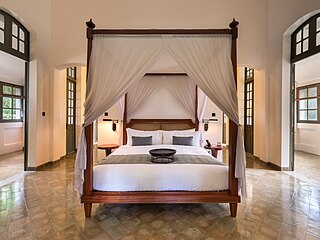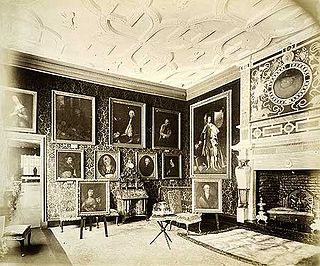
Queen's House is a former royal residence in the London borough of Greenwich, which presently serves as a public art gallery. It was built between 1616 and 1635 on the grounds of the now demolished Greenwich Palace, a few miles downriver from the City of London. In its current setting, it forms a central focus of the Old Royal Naval College with a grand vista leading to the River Thames, a World Heritage Site called, Maritime Greenwich. The Queen's House architect, Inigo Jones, was commissioned by Queen Anne of Denmark in 1616 and again to finish the house in 1635 by Queen Henrietta Maria. The House was commissioned by both Anne and Henrietta as a retreat and place to display and enjoy the artworks they had accumulated and commissioned; this includes a ceiling of the Great Hall that features a work by Orazio Gentileschi titled Allegory of Peace and the Arts.

Knole is a country house and former archbishop's palace owned by the National Trust. It is situated within Knole Park, a 1,000-acre (400-hectare) park located immediately to the south-east of Sevenoaks in west Kent. The house ranks in the top five of England's largest houses, under any measure used, occupying a total of four acres.

The original Knole Settee is a couch chair made in the 17th century, probably around 1640. It is housed at Knole in Kent, a house owned by the Sackville-West family since 1605 but now in the care of the National Trust.

Upholstery is the work of providing furniture, especially seats, with padding, springs, webbing, and fabric or leather covers. The word also refers to the materials used to upholster something.

Dunfermline Palace is a ruined former Scottish royal palace and important tourist attraction in Dunfermline, Fife, Scotland. It is currently, along with other buildings of the adjacent Dunfermline Abbey, under the care of Historic Environment Scotland as a scheduled monument.

Lionel Cranfield, 1st Earl of Middlesex was an English merchant and politician. He sat in the House of Commons between 1614 and 1622 when he was raised to the peerage as Baron Cranfield.

Oatlands Palace is a former Tudor and Stuart royal palace which took the place of the former manor of the village of Oatlands near Weybridge, Surrey. Little remains of the original building, so excavations of the palace took place in 1964 to rediscover its extent.

George Home, 1st Earl of Dunbar, KG, PC was, in the last decade of his life, the most prominent and most influential Scotsman in England. His work lay in the King's Household and in the control of the State Affairs of Scotland and he was the King's chief Scottish advisor. With the full backing and trust of King James he travelled regularly from London to Edinburgh via Berwick-upon-Tweed.

A canopy bed is a bed with a canopy, which is usually hung with bed curtains. Functionally, the canopy and curtains keep the bed warmer and screen it from light and sight. On more expensive beds, they may also be elaborately ornamental.

Watts & Co. is a prominent architecture and interior design company established in England in 1874. It is a survivor from the Gothic Revival of the nineteenth century: a firm founded in 1874 by three leading late-Victorian church architects – George Frederick Bodley, Thomas Garner and Gilbert Scott the younger – to produce furniture, textiles, stained glass windows, and needlework in a style distinctively their own. Today, the company is mainly known for its clerical vestments and textile church furnishings.
Thomas Capp or Cappe was a London-based painter and gilder.

Caffoy was a cut pile woolen velvet material popular for upholstery. It was a decorative textile characterized by its wool pile designs, which were designed to imitate the appearance of silk velvets and damasks. It was originally made from wool and was used to imitate silk furnishing damasks. However, in the 16th century, it may have also been made from silk. Norwich, a major center for worsted weaving, was a major producer of caffoy. In 1579, it was featured alongside other contemporary fabrics such as Darnex, Mockado, and figure-sized Russel in a pageant commemorating the queen's visit to Norwich. Caffoy was` popular during the 17th and early 18th centuries.

Furniture and furnishings in early modern and late medieval Scotland were made locally or imported, mostly from Flanders and France. Although few pieces of furniture survive from the early part of the period, a rich vocabulary and typology is preserved in inventories and wills. This documentary evidence in the Scots language details the homes of the wealthy and aristocratic. Textiles and beds belonging to Mary, Queen of Scots are very well documented. Scottish wooden furniture was often carved with the initials of married couples.
William Portington (1544-1628) was an English carpenter and joiner, originally from St Albans, employed by Elizabeth I and James VI and I. He was master carpenter of the Office of Works.

The coronation of James I and his wife Anne as King and Queen of England and Ireland was held on 25 July 1603 at Westminster Abbey. James had reigned as King James VI of Scotland since 1567. Anne was anointed and consecrated with prayers alluding to Esther, the Wise Virgins, and other Biblical heroines. It was the first coronation to be conducted in English instead of Latin. Because of the 1603 London plague, a planned ceremonial Royal Entry to London was deferred until 15 March 1604.

Sophia Stuart was the fourth daughter and last of nine children of James VI and I and Anne of Denmark.

James VI and I (1566–1625), King of England, Scotland, and Ireland, died on 27 March 1625 at Theobalds, and was buried at Westminster Abbey on 7 May 1625.

Anne of Denmark (1574–1619) was the wife of James VI and I, and queen consort of Scotland from 1589, and queen consort of England and Ireland from the union of the Scottish and English crowns in 1603 until her death on 2 March 1619 at Hampton Court. She was buried at Westminster Abbey on 13 May.
Benjamin Henshawe (1585–1631) was a London merchant tailor and silkman who supplied fabrics and passementerie for costume and furnishings for the royal court. His widow, Anna Henshawe, continued in business with William Geere.
Ralph Grynder or Grinder was a London-based furniture maker and upholsterer who worked for Charles I of England and Henrietta Maria. He bought and sold art treasures from the Royal Collection in 1651.
















